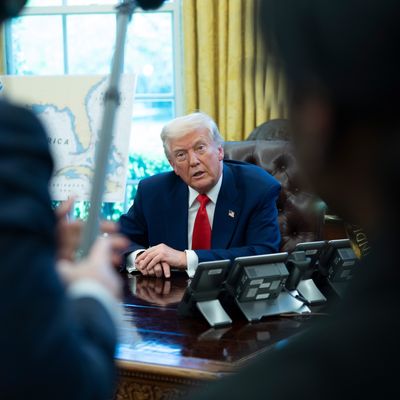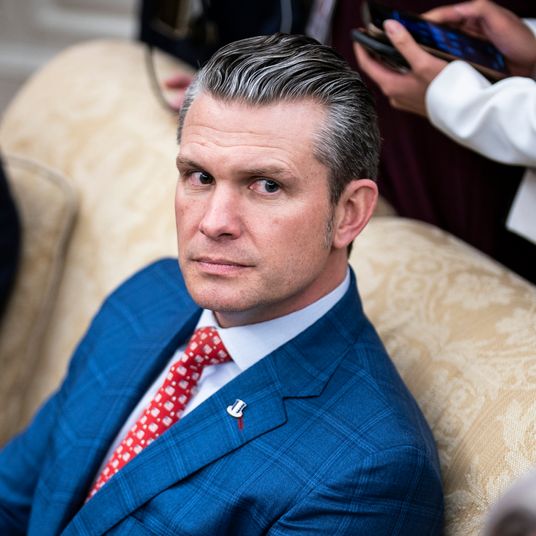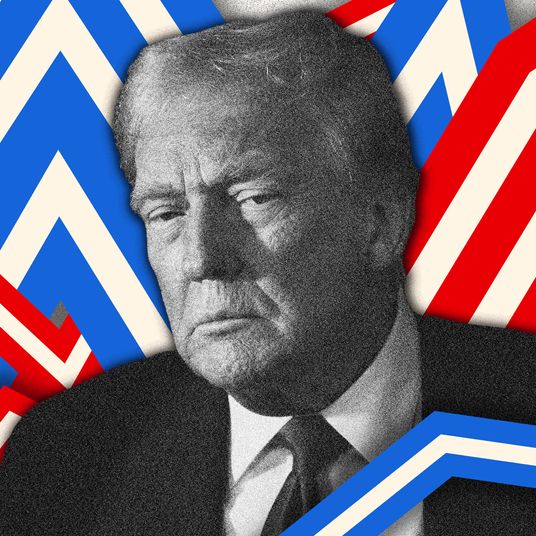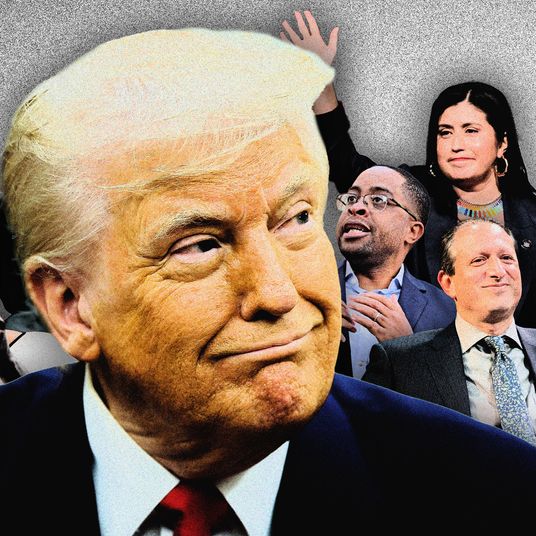
In a sudden about-face on Wednesday, Donald Trump announced a 90-day pause of many of his hefty “Liberation Day” tariffs on America’s trading partners, following days of tumult on Wall Street and growing expectations that Trump’s trade war would trigger economic catastrophe. His announcement bolstered a massive but short-lived upswing in the markets, and in the aftermath, numerous explanations and reports have emerged to explain why Trump caved. Below is a look at the biggest questions and craziest details since his big reversal.
.
What did Trump announce?
Here’s what he wrote on Truth Social on Wednesday afternoon:
Based on the lack of respect that China has shown to the World’s Markets, I am hereby raising the Tariff charged to China by the United States of America to 125%, effective immediately. At some point, hopefully in the near future, China will realize that the days of ripping off the U.S.A., and other Countries, is no longer sustainable or acceptable. Conversely, and based on the fact that more than 75 Countries have called Representatives of the United States, including the Departments of Commerce, Treasury, and the USTR, to negotiate a solution to the subjects being discussed relative to Trade, Trade Barriers, Tariffs, Currency Manipulation, and Non Monetary Tariffs, and that these Countries have not, at my strong suggestion, retaliated in any way, shape, or form against the United States, I have authorized a 90 day PAUSE, and a substantially lowered Reciprocal Tariff during this period, of 10%, also effective immediately. Thank you for your attention to this matter!
.
Okay, but what does that actually mean?
Trump paused, for 90 days, the new reciprocal tariffs on every country except China, but left in place the 10 percent global tariff — which doesn’t apply to Canada and Mexico. He also raised the tariff on China to 125 percent from the 104 percent he had raised it the day before. (On Thursday, the White House clarified that the rate was actually 145 percent — once you add in the 20 percent tariff Trump had previously levied on China before the “Liberation Day” mayhem began.)
And Trump claimed the reason for the pause is because more than 75 countries reached out to the U.S. to negotiate instead of responding with retaliatory tariffs, so he was rewarding them while punishing China.
.
But a Trump official said Canada and Mexico would face the 10 percent tariff.
Soon after Trump posted about the pause, Treasury Secretary Scott Bessent — who was reportedly intimately involved in the drafting of Trump’s announcement — said that the new policy meant that Canada and Mexico were no longer excluded from Trump’s new global 10 percent tariff. The White House later clarified that the two countries were still excluded.
.
So, Trump’s trade war isn’t over?
No, definitely not. There is still a new 10 percent tariff on virtually all exports to the U.S.; Trump’s new auto-industry tariffs are still in effect; and he’s now escalating the trade war with China. The reciprocal tariffs are temporarily paused, and that’s it.
.
The White House had called the idea of a pause ‘fake news.’
On Monday, stock markets briefly surged due to the spread of an erroneous report that Trump was considering a 90-day pause. The White House quickly shut down the speculation, writing on an official X account: “Wrong. Fake News.”
.
Trump officials have tried to frame the pause as strategic brilliance.
Shortly after Trump announced the pause, Scott Bessent spoke about what led to Trump’s pause and insisted “this was his strategy all along.” He also denied that the bond market prompted the reversal. White House press secretary Karoline Leavitt and billionaire Trump-backer Bill Ackman both suggested that Trump’s big about-face was a classic move out of his Art of the Deal playbook.
Deputy chief of staff Stephen Miller made it all sound like a historic masterstroke:
Trump himself contradicted all these remarks when speaking with reporters on Wednesday.
So, no, this wasn’t all part of the plan.
.
And the Trump team had repeatedly said the tariffs weren’t a negotiating ploy.
After Trump announced his “Liberation Day” tariffs, the White House, Trump, and his allies repeatedly insisted that the reciprocal tariffs weren’t an effort to force other countries to the negotiating table. That began to change after the market turmoil continued, and now the negotiating-leverage is part of the White House’s retroactive rationale for Trump’s big aborted plan.
.
Did Trump show any early signs that he was switching course? Did he tip anyone off?
Not exactly. Early Wednesday morning, after days of insisting he would not change course, the president was still projecting confidence on social media. “BE COOL! Everything is going to work out well. The USA will be bigger and better than ever before!” he said in a Truth Social post.
Trump also declared in a follow-up Truth Social post that “THIS IS A GREAT TIME TO BUY!!! DJT.” That post is now drawing scrutiny from Democrats.
.
What has Trump said about why he paused the tariffs?
Speaking with reporters on Wednesday, Trump insisted he had come to his own conclusion “over the last few days,” but that “it probably came together early this morning, fairly early this morning.” He noted that people were complaining a lot:
I thought that people were jumping a little bit out of line. They were getting yippy. You know, they were getting a little bit yippy, a little bit afraid.
The president also said that he had been watching the bond market, which experienced a massive sell-off of government bonds on Tuesday:
I was watching the bond market. It’s very tricky. If you look at it now, it’s beautiful. The bond market right now is beautiful. But I saw last night where people were getting a little queasy.
Trump also said he was necessarily “flexible.”
.
Why did Trump pause the tariffs, really?
There were reportedly multiple factors that played a role in Trump’s sudden shift, but the market reaction to the new tariffs was the primary one. In addition, Trump faced growing pressure from a variety of advisers and others, who appear to have ultimately succeeded in convincing him to change course. Multiple reports indicate that Scott Bessent was instrumental. According to the New York Times, Bessent began trying to sway Trump on Sunday:
Mr. Bessent rode with Mr. Trump back to Washington on Air Force One. During the flight, Mr. Bessent advised the president to focus on negotiating with other countries, saying Mr. Trump is the most deft negotiator there is, four people briefed on the discussion said. But he also stressed that Mr. Trump needed to articulate the endgame of his plan because the markets needed more certainty.
The Times added that on Wednesday morning, Bessent and others stressed the bond market anxiety as well:
Soon after Mr. Trump posted his [“TIME TO BUY”] missive on social media, he met in the Oval Office with Mr. Bessent, Mr. Lutnick and Kevin Hassett, the director of the National Economic Council. They discussed with the president the 10-year Treasury yield, emphasizing concern about the health of the broader U.S. financial system. Mr. Trump, in particular, understood what the rise in bond yields would mean for banks and their long-term lending, a topic he understands intimately from his years running a real estate company.
Business leaders worked on Trump, too, even going so far as to strategically appear on Fox News when they knew the president would be watching. According to the Washington Post, the president saw a Fox News interview with Jamie Dimon, the CEO of JPMorgan, on Wednesday morning where the executive warned that a recession was a “likely outcome” based on the economy’s current trajectory. The Post also reported that a group of Republican senators also appeared on Fox News on Tuesday night in an attempt to influence the president and later held an hour-long call with him.
The Wall Street Journal reports that CEOs had been blowing up White House chief of staff Susie Wiles’s phone in recent days.
This was likely spin, but Commerce secretary Howard Lutnick told Bloomberg that Trump was encouraged by the responses from other nations that were willing to come to the table to put an end to the tariffs:
The flood of outreach from other countries now making “the right kind of offers” also played a role, Lutnick said. Trump was particularly intrigued that countries were beginning to offer concessions that hadn’t previously been on the table, including addressing non-tariff trade barriers. “It just became crazy, the amount of calls we got,” Lutnick said.
.
Which “more than 75” countries have contacted the U.S. to negotiate over the tariffs?
The White House hasn’t released a list, but many countries have publicly acknowledged reaching out to the Trump administration, including Japan, Vietnam, Indonesia, Cambodia, Thailand, India, South Korea, the U.K., Switzerland, and others.
.
What happens over the next 90 days? What will prevent this craziness from happening again?
That’s not clear. Trump on Thursday vowed to reenact the reciprocal tariffs if countries don’t cut deals with the U.S. He also said he might extend the pause.
.
What have Democrats said about the pause?
Many in the party took a similar approach to Senate Minority Leader Chuck Schumer, who focused on the erratic nature of Trump’s tariff policies and the market upheaval it left in its wake, calling the last eight days “an absolute embarrassment” on social media.
Others focused on Trump’s initial push for Americans to buy stock ahead of his eventual pause, questioning the timing of his directive and whether the president was attempting to manipulate the markets. Representative Alexandria Ocasio-Cortez raised the specter of insider trading, saying that all members of Congress should disclose their stock purchases from the past 48 hours. “I don’t think that Trump just coincidentally said ‘buy stocks’ and then, shortly later, made an announcement that dramatically raised a lot of these asset prices,” she told NY1. “I’ve heard murmurings on the floor that there may have been people who knew that this was coming.”
Similarly, Senator Adam Schiff of California and Senator Ruben Gallego of Arizona cited Trump’s social media post in a letter to U.S. Trade Representative Jamieson Greer and White House Chief of Staff Susie Wiles, seeking to learn if Trump, his family or any top officials “engaged in insider trading or other illegal financial transactions” related to advanced knowledge of the pause.
This post has been updated.





























